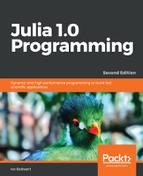In this section, we will demonstrate the power and flexibility of functions (example code can be found in Chapter 3first_class.jl). Firstly, functions have their own type: Function. Functions can also be assigned to a variable by their name:
julia> m = mult julia> m(6, 6) #> 36
This is useful when working with anonymous functions, such as c = x -> x + 2, or as follows:
julia> plustwo = function (x)
x + 2
end
(anonymous function)
julia> plustwo(3)
5
Operators are just functions written with their arguments in an infix form; for example, x + y is equivalent to +(x, y). In fact, the first form is parsed to the second form when it is evaluated. We can confirm it in the REPL: +(3,4) returns 7 and typeof(+) returns Function.
A function can take a function (or multiple functions) as its argument, which calculates the numerical derivative of a function f; as defined in the following function:
function numerical_derivative(f, x, dx=0.01)
derivative = (f(x+dx) - f(x-dx))/(2*dx)
return derivative
end
The function can be called as numerical_derivative(f, 1, 0.001), passing an anonymous function f as an argument:
f = x -> 2x^2 + 30x + 9 println(numerical_derivative(f, 1, 0.001)) #> 33.99999999999537
A function can also return another function (or multiple functions) as its value. This is demonstrated in the following code, which calculates the derivative of a function (this is also a function):
function derivative(f)
return function(x)
# pick a small value for h
h = x == 0 ? sqrt(eps(Float64)) : sqrt(eps(Float64)) * x
xph = x + h
dx = xph - x
f1 = f(xph) # evaluate f at x + h
f0 = f(x) # evaluate f at x
return (f1 - f0) / dx # divide by h
end
end
As we can see, both are excellent use cases for anonymous functions.
Here is an example of a counter function that returns (a tuple of) two anonymous functions:
function counter()
n = 0
() -> n += 1, () -> n = 0
end
We can assign the returned functions to variables:
(addOne, reset) = counter()
Notice that n is not defined outside the function:
julia> n ERROR: n not defined
Then, when we call addOne repeatedly, we get the following output:
addOne() #=> 1 addOne() #=> 2 addOne() #=> 3 reset() #=> 0
What we see is that, in the counter function, the variable n is captured in the anonymous functions. It can only be manipulated by the functions, addOne and reset. The two functions are said to be closed over the variable n and both have references to n. That's why they are called closures.
Currying (also called a partial application) is the technique of translating the evaluation of a function that takes multiple arguments (or a tuple of arguments) into evaluating a sequence of functions, each with a single argument. Here is an example of function currying:
function add(x)
return function f(y)
return x + y
end
end
The output returned is add (generic function with 1 method).
Calling this function with add(1)(2) returns 3. This example can be written more succinctly as add(x) = f(y) = x + y or, with an anonymous function, as add(x) = y -> x + y. Currying is especially useful when passing functions around, as we will see in the Map, filter, and list comprehensions section.
